Difficulty: Average
Time Required: 10 minutes per fringe
Here's How:
Bicone Beads is the most popular beads now a days. It is the best quality and it does not require a jeweler to teach you how to make and accessories using it. You may make bicone beads as a necklace or earring ever bracelet as accessories. The innovative new type of bicone beads make it a hot demand item among the beads lovers.

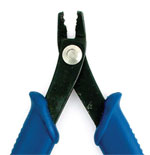 | Crimping pliers are for just what their name implies, crimping! The back slot puts a seam in the middle of the crimp tube, separating the ends of the flex wire and trapping it firmly. The front slot rounds out the tube and turns it into a small, tidy bead. |
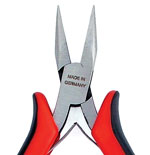 | Chain-nose pliers are the most useful tool in your entire toolbox. For holding, opening and closing jump rings and bending sharp angles. |
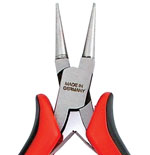 | Round-nose pliers are intended for turning round loops. They do not work well for holding or grasping since they tend to leave a small dent. |
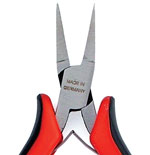 | Flat-nose pliers are a wire power tool. They are excellent for turning sharp corners, holding items and for opening and closing jump rings. |
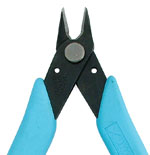 | Wire flush cutters leave one flat side and one pointed side on each cut. Using flush cutters is especially important when working with heavy gauges of wire (20-gauge or smaller). One side of the cutter is flat and the other is indented. |
 | Nylon-jaw pliers can be used to harden or straighten wire. |
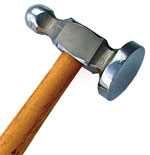 | Jeweler’s hammers have fine, smooth curved heads to leave a clean impression. The round peen side works well for texturing wire and metal sheet. |
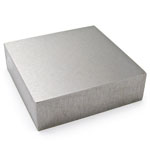 | A bench block is a flat, smooth piece of hardened steel. Hammering on top of a block flattens out and hardens the wire. Bench blocks are also used for stamping metal to get a clean impression. |
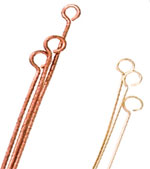 | Eye Pins are wires with a loop on one end and a straight portion of wire where beads can be strung. Length and gauges vary; most earrings use 24-gauge eye pins from 1 1/2 – 2 1/2 inches. |
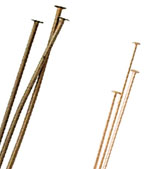 | Head Pins are a piece of wire with a stop end like a fine nail head. A bead slides onto the head pin and stops on the head. Lengths and gauges vary; most earrings use 24-gauge head pins from 1 1/2 – 2 1/2 inches. |
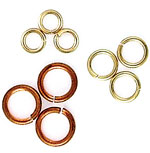 | Jump Rings are one of the most versatile findings used in jewelry-making. They come in all sizes, gauges and metals. They are measured by diameter (width) and gauge (weight). |
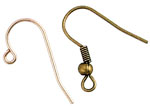 | Ear Wires come in many different styles. Regular fishhook style are the most common and the easiest to make yourself. Recommended weight for ear wires is either 22- or 20-gauge. |
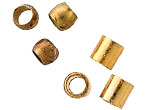 | Crimp Tubes are small soft metal cylinders that can be flattened or formed around flexible beading wire to secure the ends. They are an essential component for bead stringing projects. |
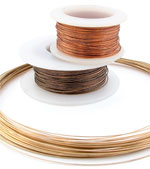 | Wire comes in many sizes or gauges. Gauge is the measured diameter of the wire. The higher the number, the thinner the wire. Wire can be tempered soft, half-hard or hard, which refers to its stiffness. Copper, silver and gold-filled are most commonly used for jewelry. |
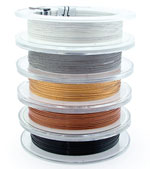 | Flexible Beading Wire comes in several weights from .010 - .026-inch diameter and is designed for stringing. It is available in precious metal and several colors and is made from 7 to 49 strands of steel wire, twisted and encased in a flexible plastic coating. Ends are finished with crimp beads using either crimping or chainnose pliers. |
Creating your own beaded jewelry is easy and only takes a few tools. Practice these techniques using less expensive metal findings. Once your finishing techniques are perfected, use real sterling silver or vermeil (real gold plating over sterling silver) to add elegance to your beadwork.
| Jump rings are one of the most versatile findings used in jewelry-making. They come in all sizes and gauges. | |
| |
| |
| Eye pins should be made with half-hard wire to make sure they hold their shape. 22-gauge will fit through most beads, with the exception of many semi-precious stones. Most Czech glass beads and 4mm crystals will fit on 20-gauge wire. |
|
Using chain-nose pliers, make a 90-degree bend 3/8 inch from end of wire. (Photo B) |
Using round-nose pliers, grasp the end of the wire so no wire sticks out between plier blades. (Photo C1) |
Begin making a loop by rolling your hand away from your body. Don’t try to make the entire loop in one movement. Roll your hand 1/4 turn counterclockwise. (Photo C2) |
Without removing pliers from loop, open plier blade slightly and pivot plier back toward your body clockwise about 1/4 turn. (Photo D) |
Close plier onto the wire and roll the loop until it comes around, next to the 90-degree bend. (Photo E) |
Open and close eye-pin loops the same way as jump rings, by pushing open front to back. (Photo F) |
|
Make a 90-degree bend about 1 1/2 inches from end of the wire using chain-nose pliers. (Photo B) |
Using round-nose pliers, grab wire about 3/8 inch away from the 90-degree and roll your hand away from yourself, toward the bend until a loop is halfway formed. (Photos C1 and C2) |
Without removing plier from forming loop, open the jaw and rotate plier clockwise about 1/4 turn. (Photo D) |
Grab the end of the wire with your left (nondominant) hand and pull it around the rest of the way until it crosses itself and completes the loop. (Photo E) |
Switch to chain-nose pliers, holding across the loop. Wrap tail around wire under loop with your left hand. If you are using a heavy gauge of wire, it is often easier to use a second plier to pull the tail around instead of your fingers. (Photos F1 and F2) |
Flush cut wire as close to the wrap as possible. Tuck end down if needed, using chain-nose pliers. (Photos G1 and G2) |
To create a wrap on the opposite end of the bead, leave a gap equal to wrap space on first end. Grasp to the right of the wrap space and make a 90-degree bend. (Photos H1 and H2) |
Repeat from Photo C–H to complete. |
Hammering hardens and flattens round wire. This can be especially important when making ear wires or clasps that need to hold their shape. Always use a smooth, hardened steel surface to guarantee a clean finish. Any marks or scars on a bench block or hammer will impress on the surface of wire or sheet metal. |
|
String a crimp bead onto flexible wire. String clasp or ring and pass tail of flexible wire back through crimp to form a loop. |
|
Put oval into back slot of plier and squeeze to make fold in the center with one wire on each side of fold. (Photo B) |
Return to front slot, and squeeze again to tighten crimp. Do a few more rotations and squeezes to solidify and shape crimp bead. Trim wire tail. (Photo C) |
Cut a piece of thread about 5 or 6 inches long, or longer if that makes it easier to work with.
Thread two 3 mm bicone beads to mark the center of the thread.
On the each side of them thread one 3mm bicone bead and one 3mm bicone bead.
Re thread the end of the thread through each 5 mm bicone bead respectively.
Add a 3 mm bicone to each respective end of the thread.
Knot the thread and cut off the excess as close to the beads as possible.
Cut a piece of thread about 5 or 6 inches long, or longer if that makes it easier for you to work with.
Thread six 6 mm rivoli beads in a row.
Knot the ends, forming a circle, cut the left over thread as close to the beads as possible.
Repeat Steps 1 through 3 of this section with the 8 mm rivoli beads.
Slide the circle of 8 mm rivoli beads on the eyepin followed by the circle of 6 mm rivoli beads then the bicone arms.
Last, slide the doll head, or the bead you are using for the head, on the eyepin.
Using the round nose pliers, roll the end of the eyepin down towards the head/bead to create a loop









Swarovski are to alter their anytime accepted and chump favourite bicone beads with the new and bigger Xillion bead.
From June 2nd through September 2009 CRYSTALLIZED™ - Swarovski Elements will alteration to the ablaze XILION advancement of the 5301 Bead, represented by the new and bigger article:
5328 XILION Bead.
The advocate XILION cut, with its alternating ample and baby facets, after-effects in abnormally college accuracy and decidedly acute ablaze reflection. In addition, this cut is differentiated from all added articles on the bazaar and absorb protected. The added cardinal of facets enhances the all-embracing actualization of the beads and the bastard belt band aftereffect in bigger cutting abundance of the accomplished design. You will account from the different XILION brilliance, arch to clearer adverse amid your articles and designs and those of your competitors.
The alluring XILION cut will be activated to all accepted sizes of the bicone beads except for 2.5 mm, which is too baby to be upgraded. As was the case for all added XILION products, the commodity cardinal will additionally be afflicted and will now become art. 5328.
The new commodity will be accessible – after any added amount access – in the aforementioned array as the absolute commodity 5301. For application, the 5301 and 5328 XILION bicone beads can be accumulated as their ambit and geometry are complimentary.
From June 2nd through September there will be a alteration period. During that time art. 5328 can alone be ordered and will alone be shipped, if the analogue 5301 is out of stock.
Thanks for visiting biconebeads.blogspot.com. Keep visiting us for latest update about bicone beads.
Product Information
A bag of 20, 4mm clear Swarovski crystal beads with an AB coating. Very pretty beads with a fantastic sparkle.
Bead Code: 5301 (bicone)
Size: 4mm
Size of hole: 0.9mm
Colour: Crystal (001)
Coating: AB

Product Information
A bag of 20, 4mm Siam red Swarovski crystal beads. Very pretty beads with a fantastic sparkle.
Bead Code: 5301 (bicone)
Size: 4mm
Size of hole: 0.9mm
Colour: Siam (208)

Product Information
A bag of 20, 4mm light rose pink Swarovski crystal beads. Very pretty beads with a fantastic sparkle.
Bead Code: 5301 (bicone)
Size: 4mm
Size of hole: 0.9mm
Colour: Light Rose (223)

Product Information
A bag of 20, 4mm Peridot green Swarovski crystal beads. Very pretty beads with a fantastic sparkle.
Bead Code: 5301 (bicone)
Size: 4mm
Size of hole: 0.9mm
Colour: Peridot (214)

Product Information
A bag of 20, 4mm Emerald green Swarovski crystal beads. Very pretty beads with a fantastic sparkle.
Bead Code: 5301 (bicone)
Size: 4mm
Size of hole: 0.9mm
Colour: Emerald

Product Information
A bag of 20, 4mm Topaz orange Swarovski crystal beads. Very pretty beads with a fantastic sparkle.
Bead Code: 5301 (bicone)
Size: 4mm
Size of hole: 0.9mm
Colour: Topaz (203)
Design the layout of your bicone necklace on your bead board. Decide how long you would like your necklace to be. A necklace that dips right below your collar bone should measure 17 to 19 inches. Divide the bicone beads into three groups and lay them out in three staggered rows.
Cut a length of wire 6 inches longer than you want the shortest strand on the necklace to be. Cut two more pieces of wire, one 7 inches longer and one 8 inches longer. The differing lengths will create a layered look in your finished piece.
String a crimp bead onto the shortest piece of wire and run the wire end through one half of the clasp. Bring the end back through the crimp bead to create a loop around the clasp attachment point. Pull the loop tight and crimp the bead in place. Trim any excess wire and repeat with the other two lengths of wire.
Situate the necklace so the end with the attached clasp is on your left-hand side. String a crimp bead onto the shortest wire and crimp it in place immediately to the left of where your first bicone will be. Add the bicone to the wire and pull it up against the crimp bead. String another crimp bead onto the wire and secure in place on the other side of the bicone. Repeat this process with all remaining bicone and crimp beads, working from the shortest strand to the longest.
Repeat step 3 with the right-hand side of the necklace and the other side of the clasp.
Divide your headpins into two groups of three each. Thread the bicone beads onto the headpins so that each group has a headpin with one bead, a headpin with two beads and a headpin with three beads.
Grasp the tip of the first headpin with your round nose pliers. Wrap the headpin around the pliers to form a loop. Wrap each remaining headpin around the same part of the pliers to ensure loops of the same size.
Open the loop on the bottom of the ear wire by holding each side of the opening with each pair of pliers and twisting them apart. String the group of three headpins onto the loop, making sure each headpin faces the same direction. Add the headpin with three bicones first, followed by the two-bead and single-bead headpins respectively.
Close the ear wire by reversing the twisting motion with your pliers. Pinch the loop completely closed with your chain nose pliers. Repeat with the other earring.